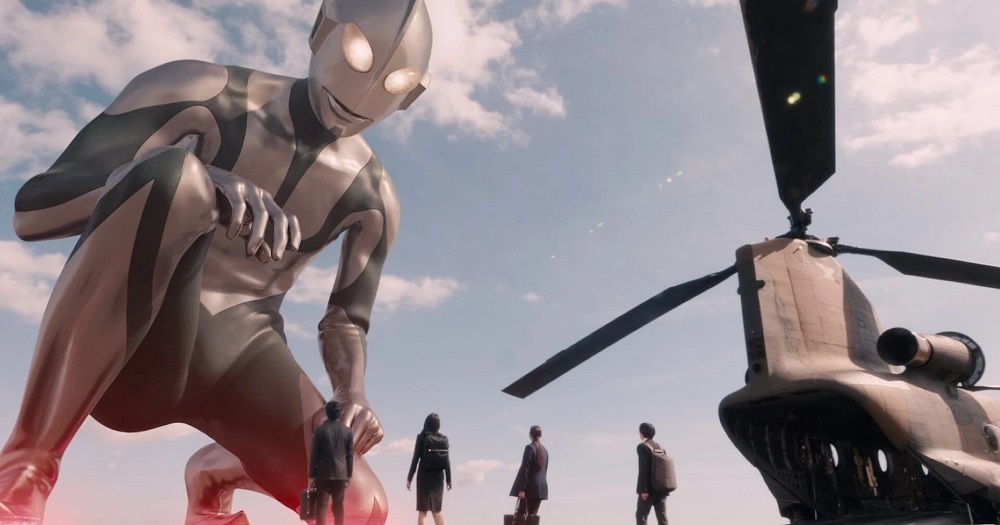Mystery Switches and Other Hidden Secrets of Shin Ultraman
How director Shinji Higuchi made a very loyal reboot
By Richard Whittaker, 6:00AM, Sat. Jan. 7, 2023

Shhhh. Shinji Higuchi has a little secret. If you look very, very carefully in the right ear of Ultraman, the giant robot superhero of his new film Shin Ultraman, he's hidden a switch.
Sitting in one of the karaoke rooms at the Alamo Drafthouse that doubles as a press suite during Fantastic Fest, he grins as he grabs a Sharpie, some tape, and a poster for his new movie, which had just received its US premiere. Carefully, he places a small piece of tape over the ear, and draws a little on/off switch. In the original series, he explains, that's where the production designers hid the light switch for the glowing eyes in the Ultraman suit. For this new version (which debuts in cinemas next week via two nights of Fathom Events screenings), he hid a tiny switch in the revamped costume, as one of many nods to the mechanical hero's TV roots.
The word "shin" in Shin Ultraman doesn't quite have a singular analog in English. It roughly translates in three ways, as new, true, and god, but it has a broader resonance as reflecting the ultimate, most honest, and evolved version of an entity.
That almost undefinable idea of finding the inner truth speaks to Higuchi's ongoing project with Hideaki Anno that began in 2016 with the critically-acclaimed box office leviathan Shin Godzilla (which the pair codirected), and the upcoming Shin Kamen Rider (directed by Anno), opening in Japan this coming March. The films are not merely reboots of beloved tokusatsu (the Japanese term for FX-heavy fantastical stories), even though they undoubtedly reset the clocks on all three: instead they feel like a rebirth, contemporizing the stories and characters while remaining fundamentally loyal to the originals.
Ultraman may be less known to international audiences than Godzilla, but his place in pop culture is assured as one of the original Kyodai heroes - creatures, robots, and superheroes that can grow to giant size to fight off monsters. Created by Tsuburaya Productions (the studio founded by Godzilla FX whizz Eiji Tsuburaya), over the last 57 years he and his fellow gigantic heroes have starred in dozens of TV shows, video games, manga, and films.
Ultraman has been a part of Higuchi's life for as long as he can remember: indeed, he was only nine months old when the first series, Ultraman, debuted in July, 1966. Via translator, he said, "They used to play on TV every day in Japan, and so every time that kids would come home from school that would be when the episode would play, every day. So from the time I was a young little boy, I would watch every day."
Even as an adult, he stayed a loyal viewer to all the versions of Ultraman, but through kindergarten he was a fervent collector of all the action figures. Then he arrived at elementary school "and my mother got very worried that I was all about kaiju and Ultraman and threw them all away."
That's a story that can resonate with every science fiction fan whose well-intentioned parents sent their treasured collections to the charity shop. Yet rather than ending Higuchi's fascination with kaiju, he's now playing with the grandest toys ever. He laughed. "The sadness that I felt at the time made me keep on doing my job."
But just because Toho let grown-up Higuchi loose in their toy box, that doesn't mean that Shin Ultraman is just one giant monster mash of fight sequences. While there are plenty of creatures to defeat (would it truly be Ultraman without them?), much of the drama centers around the S-Class Species Suppression Protocol unit or SSSP, assigned to fend off the monsters. Basically, the same kind of low-level bureaucrats that were the center of Shin Godzilla, but portrayed in a much kinder light.
Why revisit that theme? "Because there is no budget," Higuchi chortled. "I really wanted to put in all the kaiju battles, but there was not enough budget for it, so we had to come up with a way that was entertaining."
So in the middle of this menagerie of monstrous beasties, one of Higuchi's biggest inspirations was in fact the works of Aaron Sorkin and most especially The West Wing, "where it's the inside of the White House, and it's the news reporters, and you're listening to the stories of the people who are handling what's going on."
Arguably, that focus on the ordinary people is the true root of Ultraman, as the progenitor series, the Ultraman-less series Ultra Q (which aired when Higuchi was only four months old), was also all about the humans. But it's not Ultraman without Ultraman, and that meant being able to undertake the latest redesign of the classic Ultraman design - or rather, yet again make what was old new again. Superficially, it hasn't changed much over time, but there were elements of the original Ultraman look that were driven by the practical demands of having an actor in a skintight suit. "They didn't want the eye holes at the time, but they needed it, and they didn't want the zipper on the back, but they needed it for the actor to get in." However, CGI doesn't need zippers or eye holes, "So what we did for Shin Ultraman was to take the concepts of the original design and make that happen."
Shin Ultraman screens Wed., Jan 11 (subtitled) and Thu., Jan. 12 (dubbed). Read our review and find showtimes here.
A note to readers: Bold and uncensored, The Austin Chronicle has been Austin’s independent news source for over 40 years, expressing the community’s political and environmental concerns and supporting its active cultural scene. Now more than ever, we need your support to continue supplying Austin with independent, free press. If real news is important to you, please consider making a donation of $5, $10 or whatever you can afford, to help keep our journalism on stands.
Jan. 13, 2023
Shin Ultraman, Shinji Higuchi, Fantastic Fest, Fantastic Fest 2022






